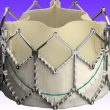The duration of percutaneous aortic valve implants can be increasingly observed over time, regardless of their corresponding surgical risk. In the follow-up of different registries, the presence of subclinical valvular thrombosis, evidenced in tomographic studies as an increase in valvular thickness with hypoattenuation (a term known as HALT), was observed from protocolized images. This subclinical...
Is the PASCAL Device Effective against MitraClip?
Mitral regurgitation (MR) is the most common valvulopathy and full medical treatment at maximal tolerated doses has been shown quite effective to treat it. However, its limited in a group of patients that require valve intervention. At present, the ideal treatment is surgical valve replacement, which is in many cases is not viable because of...
We Should Treat Significant Stable CAD in Patients Undergoing TAVR
Aortic stenosis is associated to significant coronary artery disease (CAD) in nearly 50% of cases. When we decide to treat aortic disease using surgery, it has been established we should also treat heart disease. However, when using transcatheter aortic valve replacement (TAVR), this is still unclear, given that in many occasions we see stable lesions...
Combined Calcified Lesion Preparation Strategy
Stent sub-expansion in coronary territory has been identified as one of the major predictors of stent failure at followup, which is why improving stent expansion will improve clinical and imaging outcomes. In percutaneous coronary interventions (PCI) of severely calcified lesions, calcified lesions present a major challenge since they impede stent delivery, causing stent under-expansion or...
Is Clopidogrel Monotherapy Safe After a Month of Dual Antiplatelet Therapy in Diabetic Patients?
Currently, many randomized studies have suggested that short-term dual antiplatelet therapy (DAPT) followed by monotherapy reduces bleeding without increasing major cardiovascular events after percutaneous coronary intervention (PCI). A meta-analysis of six randomized studies has shown this benefit using ticagrelor monotherapy after short DAPT. However, there is no data on the results of clopidogrel monotherapy. Researchers...
Is There any Difference between Modern Valves and Self and Balloon Expandable Valves?
At present TAVR is a valid alternative to treat different risk groups of patients with severe aortic stenosis. Among the different valves, there are two types, the self-expanding (SEV) and the balloon expandable (BEV) valves, that are the most implanted and the most researched by randomized studies across different risk groups. There are different generations...
Pulmonary Artery Denervation: Valid Alternative for Pulmonary Arterial Hypertension Grade 1?
Pulmonary vessels are densely innervated by sympathetic, parasympathetic, and sensitive fibers. According to the World Health Organization (WHO) pulmonary arterial hypertension (PAH) grade 1 consists of obliterating pulmonary vascular remodeling accompanied by a diminished generation of vessel dilators. Its pharmacological treatment has certain limitations and sympathetic pulmonary vascular denervation might be a valid treatment alternative,...
How Do We Manage Antiaggregation in BARC I Bleeding after AMI?
Dual antiplatelet therapy (DAPT) after acute myocardial infarction (AMI) has been shown useful to reduce thrombotic events, but one of its downsides is bleeding, especially in elderly patients. BARC bleeding type I, also called nuisance bleeding (NB), is of low frequency, but its evolution and impact remain unclear, as does its management. A subanalysis of...
Mitral Trial: 2-Year Followup
At present, an important group of patients with mitral valve disease are at high surgical risk, especially those with deteriorated bio-prosthesis, severe mitral annulus calcification or those who had received mitral annuloplasty. Percutaneous treatment with balloon expandable valves is a valid option to treat these patients, seeing as their 30 day and one-year outcomes look...
Valve-in-Valve Shows Good Evolution after 2 Years
The degeneration of bioprostheses in aortic position occurs at approximately after 10 to 15 years. In this scenario, the treatment of choice used to be redo surgery, but with the evolution of transcatheter aortic valve replacement (TAVR), it became a valid alternative with a level IIa B evidence. While there are currently multiple analyses of...









